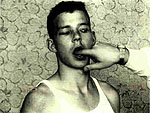 |
Vol 0, No 35
24 May 1999 |
|
|
 K I N O E Y E:
K I N O E Y E:Building a New Europe William E Jones's The Fall of Communism as Seen in Gay Pornography Andrew James Horton The changes of 1989 were intended to bring peace, prosperity and human rights to Central Europe. William E Jones's The Fall of Communism as Seen in Gay Pornography (US, 1998) looks at more worrying elements which have been introduced to post-Communist societies. The Fall of Communism as Seen in Gay Pornography has two aims and two parts which correspond to these twin goals. In the first part, "Old and New", Jones examines homo-erotic videos for sale in the US which were made in former Communist countries in order to examine the confusion the political changes have brought about. "Even in an unlikely place, it is possible to find traces of recent history," the voiceover informs us, and you can't get much more "unlikely" than in pornography. Comrades in arms Hardly noticed by the majority of viewers, the "boring parts" of pornographic films which are usually fast forwarded reveal a surprising number of anachronisms, as old and new entwine. In one video, a soldier (who is shortly to seduce a young boy) wears the uniform of the new post-Soviet Russia, above him on the wall hangs a picture of Gorbachov and on the table sits a book by Brezhnev. Such an attempt to analyse historical processes through the medium of pornography is certainly an intriguing stance. One has to credit Jones for his sheer originality. However, he can't quite live up to his promises in this section of the film. The blend of anachronisms reveals little about the processes that have occurred since 1989. It is dubious whether it even points to some sort of cultural confusion. An alternative explanation is that Central European porn - or indeed all porn - is made with little thought devoted to historical or social accuracy. This is hardly news to anyone. Even more likely is the explanation that the anachronisms are manufactured for the export audience. Cashing in on the almost comic iconography which Communism has bequeathed to lovers of kitsch, these films understandably pile on the stereotypes - without worrying whether they match each other - and flaunt the past - through titles such Comrades in Arms. The important thing is to increase the immediacy and accessibility of the picture. If anything, accuracy is something to be actively and consciously avoided, as this limits the archetypes that can be employed. This might possibly be of interest, but it tells us more about American audiences and their expectations than about the fall of Communism. The old game Jones's attempts to illustrate the plight of those caught in the Central and East European sex trade are more successful. Sex trade workers in former Communist countries only get paid one tenth the rate of their Western counterparts, and Jones highlights this exploitation by examining the inexperience of the actors. One distinctive feature of porn from this part of the world is the degree to which young actors look directly into the camera. In a montage of young faces staring straight into the lens, Jones captures something of the defiled innocence of the actors. They gaze at us with a range of expressions - nervousness, coquettishness, bemusement, expectance, defiance and exhibitionism - but the very fact that they are looking into our eyes shows us they are new to this old game. In the second and more effective part, "Screen Tests" Jones avoids elliptical analysis and brings us face to face with the true nature of Central and East European pornography. The section consists of a series of video-taped interviews between young Russian boys and a British director. The results are chilling. "You're a cute boy," purrs the director as he strokes one boy's face before embarking on a series of more intrusive physical probings of the boy, who sits there passively (see picture). Although a translator is on hand, several of the boys try out their faltering and nervous command of English as the director asks them about their sexual fantasies, what they are prepared to do on screen and even what their parents think of their chosen profession. Jones closes his expose with a conversation that summarises both sides of the parasitic relationship between porn and the former Communist countries: "Why do you want to participate in a porno film?"
At only 20 minutes long, The Fall of Communism presents some interesting material that arouses our moral outrage at the darker side of the processes of transition in post-Communist countries. There still seems to be much left that Jones has left unexplored. There is no mention, for example, of the scandal which rocked Europe in 1996: the discovery that boys from Bratislava were being abducted and transported to Holland to make films in which they were tortured. Jones could undoubtedly have made his film meatier by extending the investigative journalism aspect. Such omissions do not lessen the impact of what The Fall of Communism has actually achieved. They do, however, mean that the film is a snapshot rather than a definitive study of this horrifying subject. Andrew James Horton, 24 May 1999
|
|
![]()
Copyright (c) 1999 - Central Europe Review and Internet servis, a.s.
All Rights
Reserved